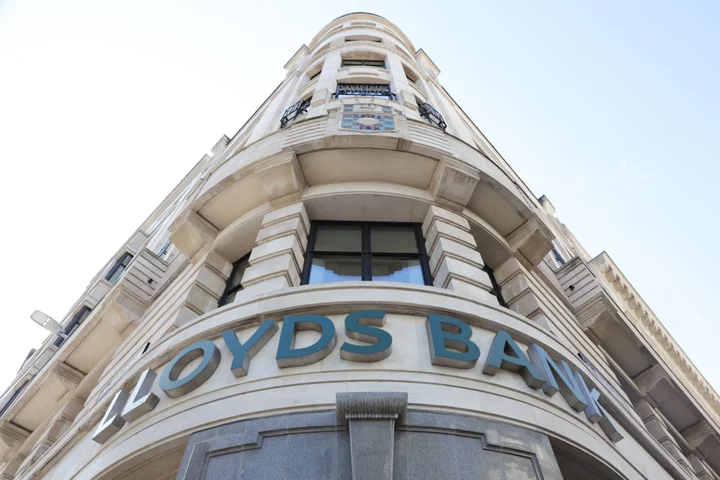Lloyds Banking Group Plc took higher bad loan charges that dragged its earnings below expectations in the second quarter, even as it raised its margins guidance, highlighting the impact of soaring interest rates on the banking industry.
Pretax profit fell to £1.6 billion ($2.1 billion), below a Bloomberg-compiled estimate of about £1.7 billion, while its net interest margin was 3.14%, a slightly better year-on-year rise than expected.
Loans and deposits fell about 1% compared to a year ago, with “modest net reductions in the open mortgage book” as borrowing costs soar. The bank booked £419 million in impairment charges for customers it fears could default — more than double the charge in the same period last year.
Shares were 4.7% lower at 8:55 a.m.
Charlie Nunn, the lender’s chief executive officer, told reporters that Lloyds did not take into consideration personal and political views when deciding to drop a customer, following the row over Nigel Farage’s accounts that led to the departure of NatWest Group Plc CEO Alison Rose earlier Wednesday.
Nunn said Lloyds was sending a representative to a meeting with Treasury ministers later today to discuss the issue of debanking. Accounts were only closed for reasons such as financial crime or when customers commit violence against staff, he said, adding he was “comfortable our policies reflect that.”
Margin Outlook
For the full year, Lloyds expects its net interest margin to be greater than 3.1%, up from previous guidance of 3.05%, while operating costs are set to reach about £9.1 billion, unchanged despite continued inflation in the UK.
“We know that rising interest rates, cost of living pressures and an uncertain economic outlook are proving challenging for many people and businesses,” Nunn said in a statement.
Nunn said customers rolling off fixed-rate mortgage deals later this year could see their monthly costs rise by an average of about £350, but expected most borrowers to cope. “We’ve seen very very low arrears levels for customers moving onto that higher level” of rates since prices shot up after the mini-budget last September, Chief Financial Officer William Chalmers told reporters.
The Bank of England has raised rates 13 times in an attempt to curb inflation, which has been stuck above the central bank’s target for almost two years, though slowed slightly to 7.9% last month. As lenders earn more on money they hold with the central bank, they have come under increasing pressure from politicians and regulators to pass more of this windfall to their customers.
Lloyds, Britain’s biggest mortgage lender, is also exposed to the slowing housing market as surging rates make repayments more expensive for borrowers on new or variable-rate loans.
The bank is working through Nunn’s strategy to grow in wealth offerings, corporate banking and digital services. The firm said on Wednesday it was on track to generate £700 million in extra revenue and £1.2 billion in gross cost savings by the end of 2024.
(Updates with share price, CEO comments throughout.)

